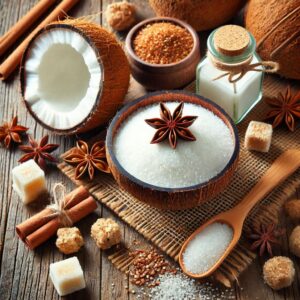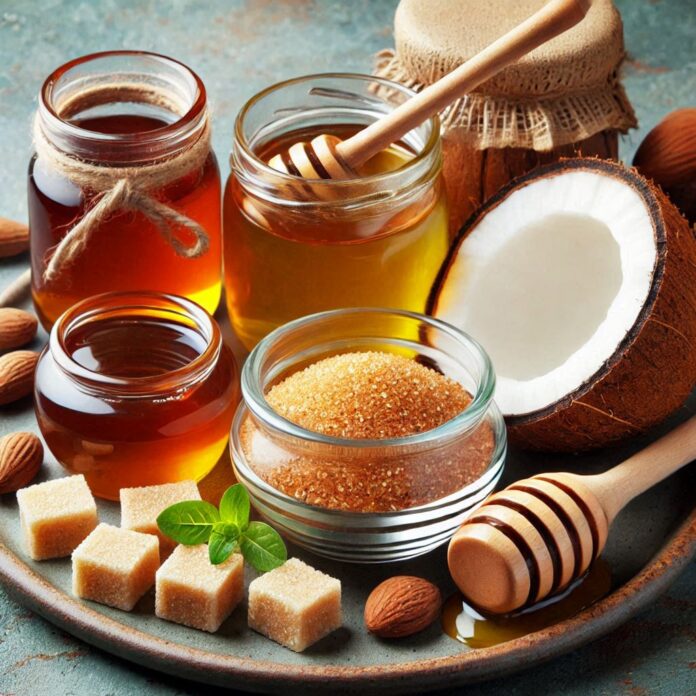Brown sugar is a staple ingredient in many recipes, offering a distinct caramel flavor and moisture to baked goods, sauces, and beverages. However, whether due to dietary restrictions, health goals, or personal preferences, many people seek a brown sugar substitute that provides sweetness without the drawbacks of refined sugars. Natural substitutes such as stevia, monk fruit extract, coconut sugar, and raw honey offer unique properties, health benefits, and culinary versatility. By understanding how to use these alternatives effectively, you can create delicious and healthier dishes without sacrificing flavor or texture.
I. Using Stevia as a Brown Sugar Substitute: Benefits and Considerations.

Stevia, a natural sweetener derived from the leaves of Stevia rebaudiana, has become a popular alternative for those looking to reduce their sugar intake. While it offers an excellent substitute for brown sugar, its unique properties require specific adjustments when used in recipes.
-What is Stevia?
Stevia is a plant-based sweetener known for its exceptional sweetness, derived from steviol glycosides in the plant’s leaves. These compounds are extracted and refined into various forms, such as liquid, powdered, or granulated. Remarkably, stevia is 200–400 times sweeter than traditional sugar, allowing minimal amounts to achieve the desired sweetness.
-Forms of Stevia:
•Liquid Stevia: Convenient for sweetening beverages like tea, coffee, and smoothies.
Often comes with a dropper for easy, precise usage.
•Powdered Stevia: Perfect for baking or cooking.
Concentration levels vary, so it’s essential to follow brand-specific guidelines.
•Granulated Stevia: Typically blended with fillers to mimic the texture of sugar.
Useful for recipes requiring bulk, such as cookies or cakes.
-Health Advantages of Stevia:
•Calorie-Free Sweetening: Stevia offers sweetness without the added calories, making it ideal for those managing weight.
•Safe for Blood Sugar: With a glycemic index of zero, stevia does not cause spikes in blood sugar, making it suitable for individuals with diabetes or low-carb diets.
•Potential Metabolic Benefits: Some studies suggest it may enhance insulin function, potentially aiding those with insulin resistance.
•Cardiovascular Support: Research indicates stevia may help reduce high blood pressure, contributing to overall heart health.
•Oral Health Benefits: Unlike sugar, stevia doesn’t promote cavities or tooth decay, making it a healthier choice for dental care.
-How to Incorporate Stevia:
Stevia’s versatility makes it a practical option in various recipes and dishes. However, its intense sweetness requires careful measurement and adjustment.
•In Beverages: A few drops of liquid stevia are enough for coffee, tea, or smoothies.
•In Baking: Substitute sugar with stevia but adjust the recipe to compensate for the lack of bulk and caramelization. Ingredients like applesauce or yogurt can help maintain texture.
•In Cooking: Ideal for sauces, dressings, and marinades, stevia holds up well to heat.
•In Packaged Foods: Commonly used in sugar-free snacks, drinks, and desserts.
-Key Considerations:
•Sweetness Levels: Stevia’s high sweetness means a teaspoon of powdered stevia can replace a cup of sugar. Always check manufacturer guidelines for accurate conversions.
•Texture and Bulk Brown sugar adds moisture and volume, which stevia cannot replicate. Compensate with ingredients like mashed bananas or pureed fruits.
•Caramelization Unlike brown sugar, stevia doesn’t caramelize. Adding a touch of molasses can provide similar flavor and color without excess sugar.
-Precautions When Using Stevia:
•Taste Sensitivity: Some people detect a slight aftertaste, often described as bitter or licorice-like. Choosing pure, high-quality products can minimize this.
• Additives in Products: Many stevia-based products include fillers like erythritol or maltodextrin. Read labels carefully to avoid unwanted ingredients.
•Consumption Limits: The FDA recommends an acceptable daily intake (ADI) of 4 mg per kilogram of body weight. Moderate use ensures safety and prevents over-sweetening.
-Recommendations:
When replacing brown sugar with stevia, keep in mind its unique properties. Experimentation and recipe adjustments may be necessary to achieve the desired flavor and texture. Opt for pure stevia products for the best results, avoiding unnecessary additives.
Stevia is a natural, calorie-free alternative to brown sugar that offers significant health benefits. By understanding its strengths and limitations, you can confidently incorporate stevia into your cooking and baking, reducing sugar consumption without sacrificing sweetness.
II. Using Monk Fruit Extract as a Brown Sugar Substitute: Benefits and Considerations.

Monk fruit extract, derived from the Siraitia grosvenorii fruit native to Southeast Asia, has gained popularity as a natural, calorie-free sweetener. Its intense sweetness, attributed to compounds called mogrosides, makes it a viable alternative to brown sugar for those seeking to reduce sugar intake. However, substituting brown sugar with monk fruit extract requires careful consideration of its unique properties to achieve the desired results in recipes.
-What is Monk Fruit Extract?
Monk fruit extract is a natural sweetener obtained from the monk fruit, also known as luo han guo. The sweetness comes from mogrosides, which are significantly sweeter than sucrose. Notably, monk fruit extract contains zero calories and does not impact blood sugar levels, making it suitable for low-carb and diabetic diets.
-Forms of Monk Fruit Extract:
•Liquid Monk Fruit Extract: Ideal for sweetening beverages such as coffee, tea, and smoothies. It allows for precise dosing with a dropper.
•Powdered Monk Fruit Extract: Suitable for baking and cooking; however, sweetness levels can vary between brands, so it’s essential to follow the manufacturer’s guidelines.
•Granulated Monk Fruit Sweetener: Often combined with bulking agents like erythritol to replicate the texture of sugar, making it appropriate for recipes that require bulk, such as cookies or cakes.
-Health Advantages of Monk Fruit Extract:
•Calorie-Free Sweetening: Monk fruit extract provides sweetness without calories, aiding in weight management efforts.
•Safe for Blood Sugar: With a glycemic index of zero, it doesn’t cause blood sugar spikes, benefiting individuals with diabetes or those on low-carb diets.
•Antioxidant Properties: Mogrosides possess antioxidant effects, contributing to overall health.
•No Dental Risks: Unlike sugar, monk fruit extract doesn’t promote tooth decay or cavities, supporting dental health.
•Anti-Inflammatory Potential: Some studies suggest that monk fruit may help reduce inflammation, offering additional health benefits.
-Incorporating Monk Fruit Extract into Recipes:
•In Beverages: Add a few drops of liquid monk fruit extract to drinks like coffee, tea, or lemonade for natural sweetness.
•In Baking: When replacing brown sugar, use powdered or granulated monk fruit sweetener. Adjust recipes to account for differences in bulk and caramelization, perhaps by adding ingredients like applesauce or yogurt to maintain moisture and texture.
•In Cooking: Suitable for sauces, marinades, and dressings, monk fruit extract can be used without concerns about added calories.
•In Packaged Foods: Monk fruit extract is commonly found in sugar-free snacks, protein bars, and beverages, providing a healthier alternative to traditional sweeteners.
-Key Considerations:
Sweetness Levels: Monk fruit extract is significantly sweeter than sugar; precise measurements are crucial. Some products are designed to be used in a 1:1 ratio with sugar, while pure extracts are much more concentrated.
Texture and Bulk: Brown sugar adds moisture and volume to recipes, which monk fruit extract alone cannot provide. Compensate by incorporating ingredients like applesauce, yogurt, or other moisture-rich components to achieve the desired texture.
Caramelization: Monk fruit extract doesn’t caramelize like brown sugar. To mimic the flavor and color, consider adding a small amount of molasses, keeping in mind the additional sugar content it introduces.
-Precautions When Using Monk Fruit Extract:
•Additives in Products: Many monk fruit sweeteners are blended with fillers such as erythritol or dextrose. Check labels to avoid unwanted ingredients, especially if you have sensitivities or dietary restrictions.
•Taste Sensitivity: Some individuals may detect a slight aftertaste, often described as fruity or herbal. Experiment with different brands to find one that suits your palate.
•Consumption Limits: While monk fruit extract is generally recognized as safe, moderation is advised to prevent over-sweetening and to maintain a balanced diet.
-Recommendations:
•Experimentation: Test monk fruit extract in various recipes to determine the appropriate balance and achieve the desired flavor and texture.
•Product Selection: Choose pure monk fruit products or those with minimal additives to ensure quality and avoid unnecessary ingredients.
•Recipe Adjustments: When substituting brown sugar with monk fruit extract, modify recipes thoughtfully, considering the differences in sweetness intensity, bulk, and moisture content.
Monk fruit extract serves as a natural, calorie-free alternative to brown sugar, offering numerous health benefits. By understanding its unique properties and making necessary adjustments in recipes, you can effectively incorporate monk fruit extract into your cooking and baking, reducing sugar consumption without compromising on sweetness or flavor.
III. Using Coconut Sugar as a Brown Sugar Substitute: Benefits and Considerations:

Coconut sugar, derived from the sap of coconut palm flower buds, has gained popularity as a natural sweetener and is often considered a healthier alternative to traditional sugars. Its caramel-like flavor and similar sweetness make it a viable substitute for brown sugar in various recipes. However, understanding its unique properties is essential for successful incorporation into your cooking and baking endeavors.
-What is Coconut Sugar?
Coconut sugar, also known as coconut palm sugar, is produced by evaporating the sap collected from the flower buds of the coconut palm tree. This process results in granules that are less refined than white sugar, retaining a rich caramel flavor and a brown hue similar to that of brown sugar. Notably, coconut sugar contains trace amounts of minerals such as iron, zinc, calcium, and potassium, and has a lower glycemic index compared to regular sugar, which may appeal to those monitoring their blood sugar levels.
-Forms of Coconut Sugar:
•Granulated Coconut Sugar: The most common form, resembling brown sugar in texture, making it suitable for direct substitution in recipes.
•Liquid Coconut Sugar: Less common, this syrup form can be used in beverages or recipes requiring liquid sweeteners.
-Health Advantages of Coconut Sugar:
•Lower Glycemic Index (GI) Coconut sugar has a GI of approximately 35, which is lower than that of regular table sugar (GI of 60–65). This lower GI indicates that coconut sugar causes a slower rise in blood glucose levels, making it a more suitable option for individuals managing blood sugar levels.
•Nutrient Content: While coconut sugar is primarily composed of sucrose, it contains trace amounts of vitamins and minerals, including iron, zinc, calcium, and potassium. Additionally, it contains inulin, a type of soluble fiber that may help moderate blood sugar spikes by slowing down the absorption of glucose.
•Less Processed: Coconut sugar undergoes minimal processing compared to regular table sugar. The production process involves collecting sap from the coconut palm, boiling it to evaporate moisture, and then cooling it to form granules or crystals. This minimal processing helps retain some of the natural nutrients present in the sap.
-Incorporating Coconut Sugar into Recipes:
•In Beverages: Dissolves well in hot liquids, making it suitable for sweetening coffee, tea, or hot cocoa.
•In Baking: Coconut sugar can replace brown sugar at a 1:1 ratio in most recipes without causing significant changes to the taste or texture. However, due to subtle differences in their properties, some adjustments may be necessary to ensure the desired outcome.
•In Cooking: Suitable for savory dishes that require a touch of sweetness, such as sauces, marinades, and dressings.
-Key Considerations:
•Sweetness Level: Coconut sugar is less sweet than brown sugar, which may affect the overall taste of the baked goods.
•Moisture Content: Brown sugar contains molasses, which gives it moisture and stickiness. Coconut sugar holds some levels of moisture but will generally result in drier baked goods than if brown sugar was used as an alternative.
•Flavor Profile: Coconut sugar has a mild caramel flavor, making it a versatile ingredient in both sweet and savory dishes. Its taste is less intense than brown sugar, allowing it to blend seamlessly into recipes without overpowering other flavors.
-Precautions When Using Coconut Sugar:
•Caloric Content: Despite its potential health benefits, coconut sugar is still high in calories and should be consumed in moderation to avoid health issues associated with excessive sugar intake.
•Allergies: Individuals with tree nut allergies should exercise caution, as coconut is classified as a tree nut by the FDA.
-Recommendations:
•Experimentation: Test coconut sugar in various recipes to determine how it affects flavor and texture, making adjustments as needed.
•Storage: Store coconut sugar in an airtight container in a cool, dry place to prevent clumping and maintain its quality.
Coconut sugar serves as a natural, minimally processed alternative to brown sugar, offering a lower glycemic index and a unique flavor profile. By understanding its characteristics and making appropriate adjustments in your recipes, you can enjoy the benefits of coconut sugar while achieving desirable culinary results.
IV. Using Raw Honey as a Brown Sugar Substitute: Benefits and Considerations.

Raw honey, a natural sweetener produced by bees from the nectar of flowers, offers a unique flavor profile and potential health benefits, making it a popular alternative to refined sugars. When considering substituting brown sugar with raw honey in recipes, it’s essential to understand the differences in composition, sweetness, and how these may affect your culinary creations.
-What is Raw Honey?
Raw honey is unprocessed honey extracted directly from the honeycomb, containing natural enzymes, antioxidants, and trace nutrients. Unlike pasteurized honey, raw honey retains its natural properties, which can contribute to its health benefits.
-Forms of Raw Honey:
•Liquid Raw Honey: The most common form, ideal for drizzling over foods or mixing into beverages.
•Creamed (Whipped) Honey: Processed to control crystallization, resulting in a spreadable consistency suitable for toast or baking.
-Health Advantages of Raw Honey:
Raw honey, unprocessed and unpasteurized, offers a range of health benefits due to its rich nutrient profile and natural properties.
•Antioxidant Properties: Raw honey is abundant in antioxidants, including phenolic compounds, which help combat oxidative stress and reduce the risk of chronic diseases.
•Antibacterial and Antifungal Effects: The natural enzymes in raw honey produce hydrogen peroxide, endowing it with antibacterial and antifungal properties that can inhibit the growth of harmful microorganisms.
•Wound Healing: When applied topically, raw honey can promote wound healing and tissue regeneration, making it effective for treating burns and skin injuries.
•Cough Suppressant: Consuming raw honey can soothe sore throats and act as a natural cough suppressant, providing relief from respiratory discomfort.
•digestive health: Raw honey contains prebiotics that nourish beneficial gut bacteria, supporting digestive health and potentially alleviating gastrointestinal issues.
•Nutrient-Rich Profile: It provides trace amounts of essential vitamins and minerals, including vitamin C, calcium, and iron, contributing to overall nutrition.
Incorporating raw honey into your diet can offer these health advantages, but it’s important to consume it in moderation due to its high natural sugar content.
-Incorporating Raw Honey into Recipes:
•In Beverages: Raw honey dissolves well in warm liquids, making it a suitable sweetener for tea, coffee, or smoothies.
•In Baking: When substituting brown sugar with honey, use about ½ to ⅔ cup of honey for every cup of brown sugar. Additionally, reduce other liquids in the recipe by ¼ cup to account for honey’s higher moisture content. Lower the baking temperature by 25°F to prevent over-browning.
•In Cooking: Honey can enhance sauces, marinades, and dressings, providing a natural sweetness and depth of flavor.
-Key Considerations:
•Sweetness Level: Honey is sweeter than brown sugar due to its higher fructose content; therefore, less honey is needed to achieve the desired sweetness.
•Moisture Content: Honey’s higher moisture content can affect the texture of baked goods, potentially making them denser or moister. Adjusting other liquid ingredients can help achieve the desired consistency.
•Flavor Profile: Raw honey has a distinct flavor that may alter the taste of your recipe. It’s advisable to use mild-flavored honey varieties when a subtle sweetness is desired.
-Precautions When Using Raw Honey:
•Caloric Content: While honey contains trace nutrients, it is still calorie-dense and should be consumed in moderation to avoid excessive calorie intake.
•Allergies: Individuals with pollen allergies should exercise caution, as raw honey may contain trace amounts of pollen.
•Infant Botulism Risk: Honey should not be given to infants under one year old due to the risk of botulism.
-Recommendations:
•Experimentation: Test honey in various recipes to understand how it affects flavor and texture, making adjustments as necessary.
•Storage: Store raw honey in a cool, dry place to prevent crystallization and preserve its quality.
Raw honey serves as a natural and flavorful substitute for brown sugar, offering additional health benefits due to its antioxidant and antibacterial properties. By understanding its characteristics and making appropriate adjustments in your recipes, you can effectively incorporate raw honey into your cooking and baking endeavors.
Conclusion:
Incorporating natural substitutes for brown sugar like stevia, monk fruit extract, coconut sugar, and raw honey into your diet allows you to enjoy sweetness while prioritizing health and wellness. Each alternative has its unique characteristics, requiring thoughtful adjustments in recipes to achieve optimal results. By experimenting and tailoring these substitutes to your culinary needs, you can embrace healthier options without compromising on the quality and enjoyment of your meals.

